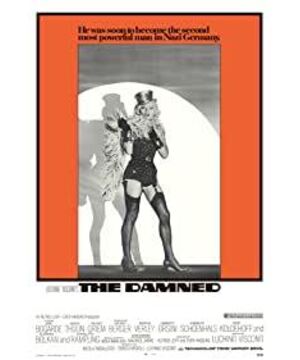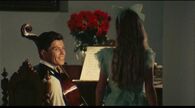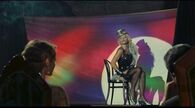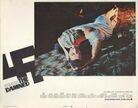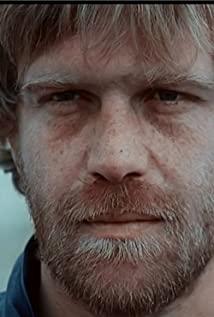#European comparative politics class recommended movie
It may be that I am not literate enough to fully appreciate director Visconti's film language. - Photo of Hindenburg. So I will follow this thread to explain my understanding:
At the beginning of the movie, there is a picture of Hindenburg on the mirror of the mansion. Who is he? Germany's war hero in World War I, was elected president of Germany by a narrow margin in 1925 as the candidate of the right-wing coalition. Hindenburg was a traditional Prussian officer, the "von" in his name showed his noble blood, he was low-key and cautious, his only public hobby was hunting, but he resisted the Treaty of Versailles and the Weimar Republic in a negative way. In his autobiography, he advocated the tradition of militarism, arguing that the military was the best university to teach young people moral qualities, and that only the monarchy could uphold the traditional values of society.
In addition to the hero of the last war, his other identity is the most respected leading figure in the German royalist party. After the defeat of the First World War, Kaiser Wilhelm II was exiled to the Netherlands as a war criminal stipulated in the Treaty of Versailles, and Germany ushered in the Weimar Republic; but this Republic did not liquidate the legacy of the old feudal system. On the contrary, a large number of old officers and aristocrats were full of resentment against the Republic: in November 1918, the German army still maintained the front lines in Belgium and France, not a single foreign soldier set foot on German soil, and the only reason for Germany to surrender was self-funded Soldiers and workers' uprisings broke out in Seoul and then spread throughout the country. This fact became the basis for the "knife in the back" myth in the future. Conservatives, royalists and even the Nazis advocated that Germany would have won the last war had it not been for leftists and Jews to stab in the back. As a war hero, with few bad deeds (the defeats were all blamed by his advisor Ludendorff), and his personal temperament is also very in line with the image of the traditional Junker aristocracy, Hindenburg naturally became the officers and nobles nostalgic for the former empire. The incarnation of the complex.
Apart from the officers and nobles who naturally benefited from the old system, the royalist tendencies among the big bourgeoisie were also evident. Unlike the liberal capitalist road in the industrial revolution in Britain and the United States, Germany's industrial development has relied on the support of government authority from the first day (about the different industrialization paths and Germany's unique state-centered industrialization model, Alexander Gerschenkron's book is very have reference value). It was the state investment, policy support and protective tariffs led by the Prussian government that led to the rise of German industry, and it was precisely because of this that the bureaucratic monopoly capitalist model in which capital and state power colluded was formed. In the future, German militarism further transformed the entire industry into a military-industrial complex that relied on armament needs. Consortiums, bureaucrats, officer-nobility (both were the same group of people, the Junkers nobility) became a solid iron for sharing power and profits. triangle.
It is against this economic background that the Krupp Group grew into a capital giant. Although the establishment of the Weimar Republic failed to shake the social and economic structure of Germany, the increasingly democratized politics undoubtedly caused the big bourgeois oligarchs to lose their original political capital, because their political allies are now in an unstable position. In this way, the big bourgeoisie also naturally sided with the royalists and united around Hindenburg with the old aristocracy, the Wehrmacht and the conservatives - as if he would lead these old elites, who were increasingly losing their privileges in the new society, to regain them All that is lost or feared to be lost. A picture of Hindenburg in the Krupp family mansion is all too normal.
But the Hindenburg in the film isn't always about this gang of dignitaries. There was such a figure of Hindenburg at the party of the stormtroopers (also known as the brown shirts), which did not show any bitterness and hatred for Hindenburg, but made fun of him. Why did the SA have another attitude towards Hindenburg?
Before the Nazi Party seized power, few established politicians and the establishment treated it as a serious political force. In their eyes, the Nazis were nothing more than a bewildered, unrealistic, street-fighting hooligan. Participants in the early Nazi movement came mainly from two groups: the part of the petty bourgeoisie that was anxious about falling status or worried about it, and the anti-Semitic and anti-Bolshevik part of the working class, plus, of course, the rogue proletarians. , speculators. The two groups have inherent political differences. The petty-bourgeois Nazis are more "reactionary" in their demands, longing for order and a prosperous society under an iron fist to maintain or restore their petty bourgeoisie status; Fanatical, anti-Semitic and anti-G, but at the same time supporting clearly left-leaning demands such as corporate nationalization, land reform and socio-economic equality. This kind of innate rift became more and more obvious after the Nazis seized power, because the gangsters who used to just shout about the Aryan nation in the streets have now really entered Berlin. In a word: The more the Nazis consolidate their position of monopoly of power, the more they will face realistic choices in governance, and the more likely internal conflicts will break out.
The stormtroopers, as the street armies of the Nazi party, were mainly composed of fanatical working-class Nazis (after all, the petty bourgeoisie, although fanatical, did not want to personally participate in "vulgar" street politics), and their daily activities were on the streets with other parties. supporters fight, bully and lure voters in elections, or bully Jewish civilians in the streets. The stormtrooper leader Ernst Rohm and the radical theoretician Strasser brothers formed the left wing of the Nazi party leadership. For them, the Nazi seizure of power was nothing but an "unfinished business" that would continue. Carry out the economic equalization reform promised in the twenty-five-point program, overthrow the monopoly of the bureaucratic bourgeoisie and the aristocracy on economic and social resources, and carry out the "revolution" to the end. So for this group of people, Hindenburg, who represents the royalists, that is, the alliance of the bureaucratic aristocratic capitalists they hate so much, is naturally long overdue to roll down the throne of the presidency.
Unfortunately, Hitler was not "elected to power" as some myths say, but was appointed chancellor by Hindenburg. According to the Weimar Constitution, the President has great power. Since 1930, the President has exercised de facto arbitrary rule for a long time by virtue of the power of emergency conferred by Article 48 of the Constitution. China has few allies. Visconti's film opens with news of the arson attack in Congress, an event that also kicks off the Nazi Party's consolidation of power—from which Hitler and his allies really came to grips with power. The factor that is even more out of the control of the royalists is that Hindenburg is already old and weak, his physical condition is deteriorating day by day, and whether he can even maintain a clear consciousness is becoming a problem. Fort, the Wehrmacht and the Royalists slipped into the hands of Hitler and the Nazis.
Since the Nazi Party's seizure of power did not depend on the so-called "popular support", then Hitler naturally did not have to please his "mass base", that is, the stormtroopers and the working-class supporters they represented. On the contrary, as the real power gradually took hold, the Nazi party, which no longer only used to talk about it, had to confront the irreconcilable contradiction between the left wing of the working class and the right wing of the petty bourgeoisie (and perhaps Hitler's personal speculation and ambition). The various dramatic plots in the film are staged one by one, power flows from Hindenburg to Hitler day by day, the rift between Hitler and Rohm, SS and SA intensifies day by day, and finally comes to this day, representing the petty bourgeoisie. The right-wing Nazi party establishment finally felt compelled to find a reason to completely liquidate the radical left wing of the party, and the night of the long knife broke out, and the stormtroopers were bloodied on the screen.
The purge of the SA and the left wing of the Nazi Party, the forces within the party representing the working class, was a prerequisite for the true convergence of the Nazi Party with the bureaucratic monopoly bourgeoisie. Hindenburg died (of natural causes) shortly after the Night of the Long Knives, so the Krupp family, who had united around Hindenburg, came to the Nazi party, because Hitler had already opened fire on his comrades by It proves that his "sozialismus" is just a rhetoric to fool the people.
At the end of the movie, the Nazi careerists took control of the Krupp family, but the photo of Hindenburg was still placed on the mirror stage of the mansion, and the stormtroopers who insulted the statue of Hindenburg fell in a pool of blood. We don't know exactly who controlled who, but there is no doubt that in the 1930s Germany there were many powerful families with Hindenburg photos in their mansions: Siemens, Farben, Bayer, Mercedes -Mercedes... These German-made products we all know are finally allied with the victorious right wing of the Nazi party, and they will then profit from the war that killed millions of people.
View more about The Damned reviews


